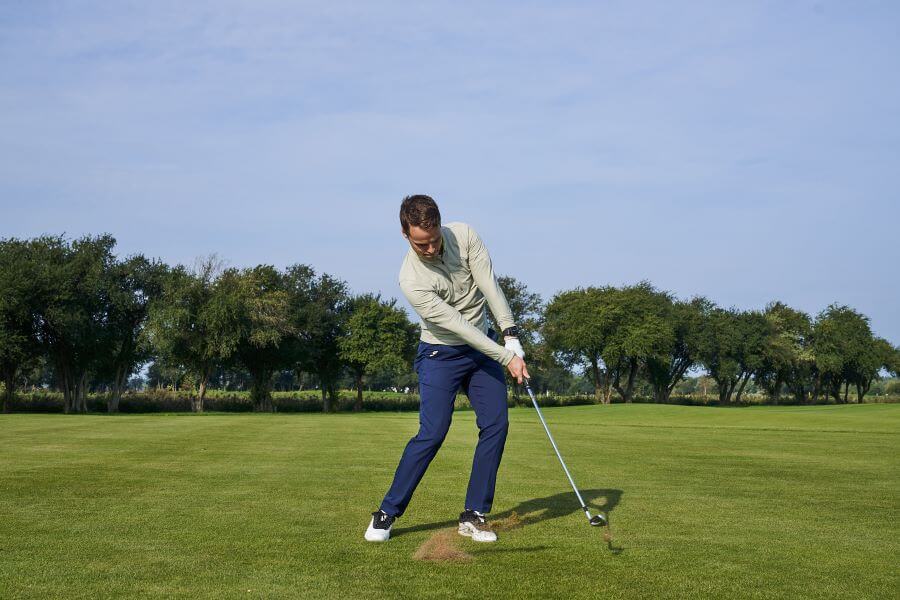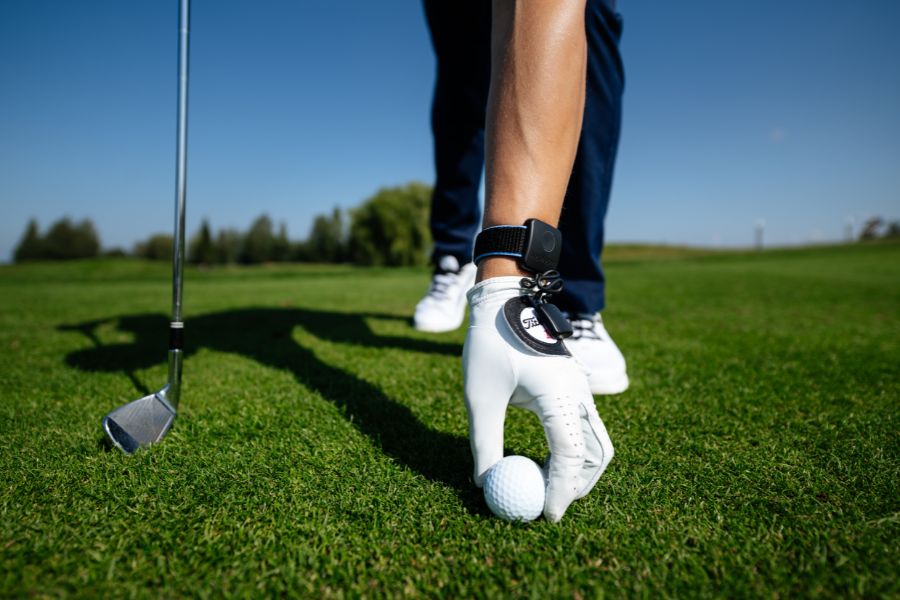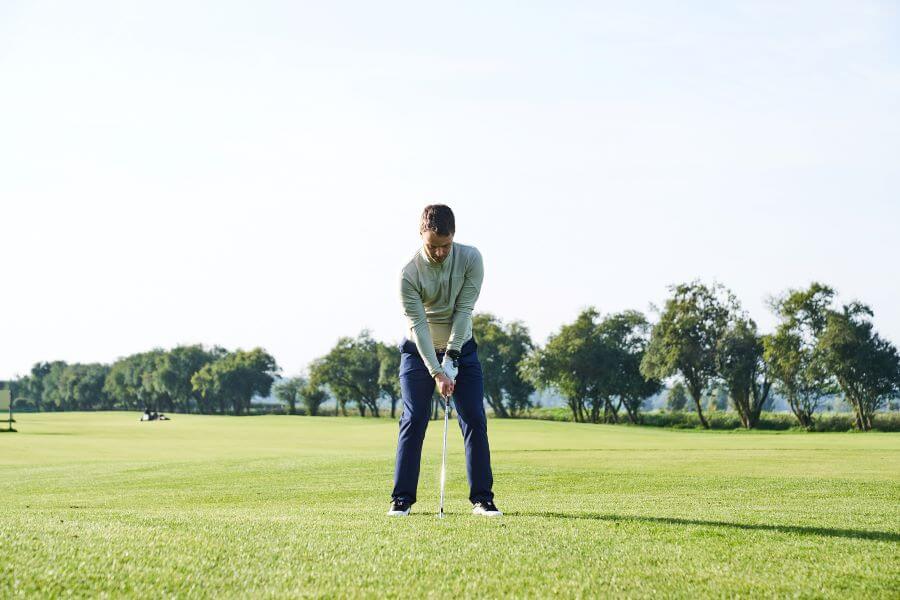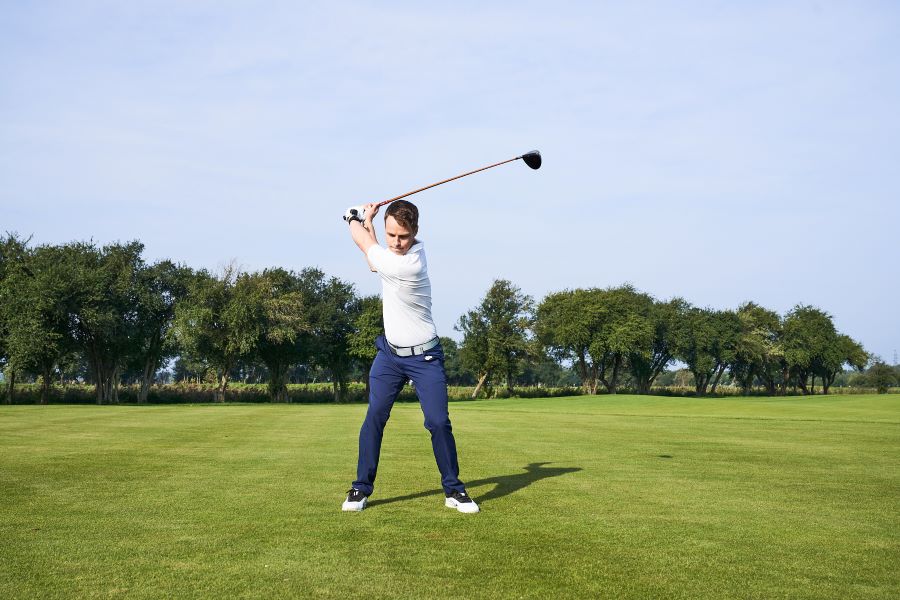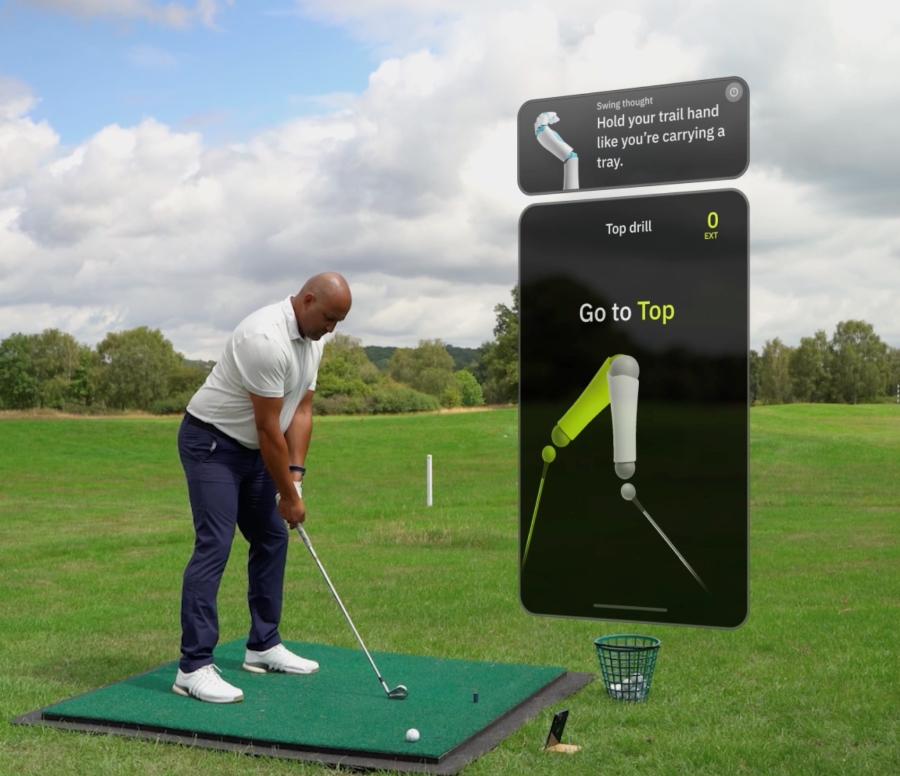17 Best Golf Swing Tips to Actually Improve Your Game
There are so many golf tips out there – too many, in fact. Golfers thrive on golf tips because they seem like the golden ticket to becoming a great player.
Here’s your fair warning: no single tip will make you a great golfer. However, one bad tip can make you a terrible golfer.
Here are 17 of the best golf swing tips to help you get better this season. These tips can be applied to any handicap player, from scratch to beginner.
Improve Your Golf Swing (Key Takeaways)
Don’t have time to read all 17 golf swing tips in great detail? Here are a few of the most important things to remember:
- Improving your golf swing is greatly impacted by your hands and wrists; make sure you understand the correct positions and angles.
- Good golf swing tips don’t always come from your friends or playing partners; be smart about what you listen to and who is saying it.
- Incorporating technology and instant feedback into your golf practice routine can help take your game to the next level.
- Golfers who want to improve their swing must be intentional about their movements and understand the proper positions in a golf swing.
- Great players consider all aspects of the game, from alignment to equipment and everything in between.
Contents
- 17 Golf Swing Tips You Can’t Afford to Miss
- Use Wrist Data to Build a More Consistent Impact Position
- Check Your Grip Before Changing Your Swing
- Focus on Clubface Angle First When Fixing a Slice
- Practice with Your Lead Hand Only to Improve Face Control
- Practice Chipping with Weight Forward to Train Compression
- Test Your Stance Setup with Alignment Sticks and Feedback
- Find Your Ideal Wrist Range, Not a One-Size-Fits-All Swing
- Accelerate Through the Ball, Don’t Ease Into Impact
- Club Up and Adjust Your Strategy in Tough Conditions
- Pick a Specific Target for Every Shot—Fairway, Green, or Putt
- Time Your Pre-Shot Routine and Stick to It
- Film Your Swing and Remove Unnecessary Movements
- Use Ground Pressure for More Power and Better Balance
- Practice Alignment with Visual Feedback Every Time
- Reset Emotionally After Every Shot—Good or Bad
- Keep Your Lead Arm Controlled—Not Locked Out
- Get Fit or Adjust Clubs That Fight Your Natural Motion
- FAQ
- Final Thoughts
17 Golf Swing Tips You Can’t Afford to Miss
Use Wrist Data to Build a More Consistent Impact Position
The role of the wrists in the golf swing is often misunderstood by amateur golfers. Your wrist angles control the clubface.
One of the best ways to get wrist movement worked out is to work with HackMotion.
HackMotion is a sensor worn on the wrist that analyzes your angle at setup and then how that angle changes throughout the swing. It’s like having your coach on your wrist.
As you wear the HackMotion sensor, you will receive real-time feedback on areas that need improvement regarding wrist movement and the flexed position required at impact.
Check Your Grip Before Changing Your Swing
If you are on the driving range this weekend, ask a few golfers about their least favorite area of the game to practice.
The answer is almost always the grip.
The golf grip is just a boring thing to practice. Whether you are new or have been around a while, it’s not nearly as exciting as trying a new takeaway or transition that is bound to lead to better ball flight and distance.
Here’s the crazy thing. The grip can be the ONLY thing you need to work on. Yes, that’s right, for some golfers, a poor grip causes all the other issues in their game.
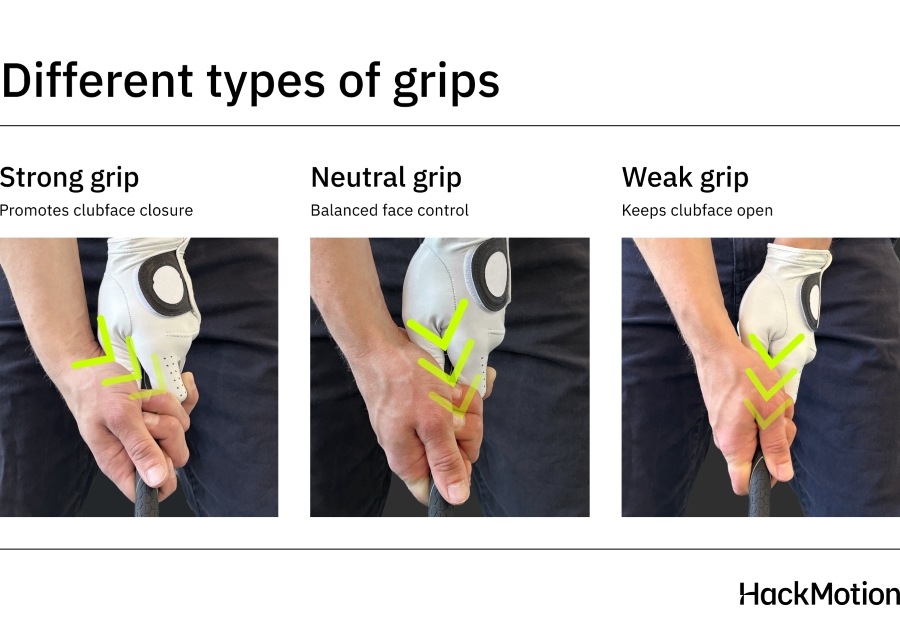
To work on the consistency of your golf grip, use the HackMotion. HackMotion measures wrist angles at setup, allowing you to compare how you set your hands on the club from one swing to the next.
Also, keep in mind that although a neutral grip is recommended, both a strong and weak grip can work.
Focus on Clubface Angle First When Fixing a Slice
If you hit a slice, your golf club face was open at impact.
Of course, you will need to do a bit more work to figure out what causes this clubface angle, but understanding that the clubface is in charge is a key factor.
See if you can move through a few swings in slow motion to see why the clubface angle is incorrect at impact; sometimes, you can feel it almost instantly.
For many golfers, stance and setup-related issues cause the clubface to be incorrect at impact.
Practice with Your Lead Hand Only to Improve Face Control
For right-handed golfers, the left hand should be in charge.
Many players get too “handsy” with their right hand, which makes it hard to control the clubface consistently throughout the round.
Try this: take a few practice swings using only your left hand. Then add your right hand back on—you’ll instantly feel how much smoother and more stable the swing becomes when the lead hand is guiding the motion.
To reinforce this concept, try the Release Drill:
Perfect Your Release with HackMotion
Fine-tune your release for consistent contact. Start with a short swing to master control before adding power.
HackMotion Release Drill – Step by Step
- Set Up: Use a shorter swing—this is not about power.
- P7 to Impact: Swing from club parallel in the downswing into impact.
- Hands Forward: Keep your hands slightly ahead of the ball at impact.
- Check Wrist Angles: Use HackMotion to confirm you’re in the correct range.
- Reps: Do at least 10 smooth reps before progressing to the Dynamic Transition Drill.
Train the lead hand to control the clubface, and let the trail hand just come along for the ride.
Practice Chipping with Weight Forward to Train Compression
If you want more height and distance with your irons, you need to compress the ball—not pick it clean off the turf.
Many amateurs try to lift the ball into the air, but the key is hitting down and through, taking a divot just after impact. That’s how you create solid contact, better launch, and consistent spin.
One of the best ways to learn compression?
Start with chipping:
- Take a narrow stance and choke down slightly
- Lean into your lead side at setup
- Keep your weight forward through impact
- Strike the ball first, then the turf
Master this on short shots, then bring that same feel to your full swing.
Test Your Stance Setup with Alignment Sticks and Feedback
The correct stance position will vary depending on the club you choose.
You have to feel comfortable standing over the golf ball. Take a session at the range to experiment with golf stance positions.
You will need an alignment stick or two; if you have a launch monitor, it certainly can’t hurt to use it.
The key is to establish a stance that you believe is correct. Start with feet shoulder-width apart, weight balanced, feet square, and clubface square.
Hit some shots from this position and see what the results are like. Once you have a baseline, experiment with different positions. Only change one thing at a time.
Find Your Ideal Wrist Range, Not a One-Size-Fits-All Swing
If you take a lesson from a golf professional who tells you there is only one correct way to swing a golf club, you may want to find a new professional.
There are lots of ways to swing a golf club and still be a great player.
Even professional golfers have swing flaws and issues because they all have unique motions in their swing. When practicing with the HackMotion, you’ll notice we always talk in ranges because there is no perfect wrist angle for every player.
We can all agree that certain features of impact must remain the same, but there are many ways to achieve this goal.
Accelerate Through the Ball, Don’t Ease Into Impact
Amateur golfers often think they need to swing slower and take it easy. Don’t do this.
In fact, one of the things that I have seen to be most detrimental to golfers is when they stop accelerating through the golf ball.
You can swing within your means, practice good tempo, and not fall over at impact. In addition, you may want to take the club back more slowly. These are important things to consider.
However, if you try to slow the club down as you move through the impact position, you will more than likely hit behind the ball or even hit a shot to the right.
Golf is a sport, and athletes who go after the ball have better distance and an easier time scoring.
Club Up and Adjust Your Strategy in Tough Conditions
When the course plays tough, wet fairways, strong wind, or extreme heat, you need to adjust.
For example, if you’re playing in heavy wind and your 9-iron usually goes 120 yards but just traveled 100, that’s your new number. Next time, club up.
Don’t worry about your averages or ego, just play the course in front of you. Every day is different, and your strategy should be too.
Pick a Specific Target for Every Shot—Fairway, Green, or Putt
How often have you stood over a golf ball and just tried to hit it straight?
Hitting it straight is a good goal, but ultimately, without a target, you may never hit it straight. All golf shots need a specific target.
The “green” or the “fairway” is not specific enough. It leaves too much room for error, making it hard for you to pull off the shot.
Try to narrow your target down to a specific spot or a line that you can go after.
Don’t just aim for the center of the fairway with no specific target in mind. When approaching the green, the same thing can be said. I pick a spot on the green, not just the flag, where I want to hit my shot. Right before I take the shot, I look at the target again and make sure I’m dialed into this specific spot.
Learn more about shot dispersion in golf here.
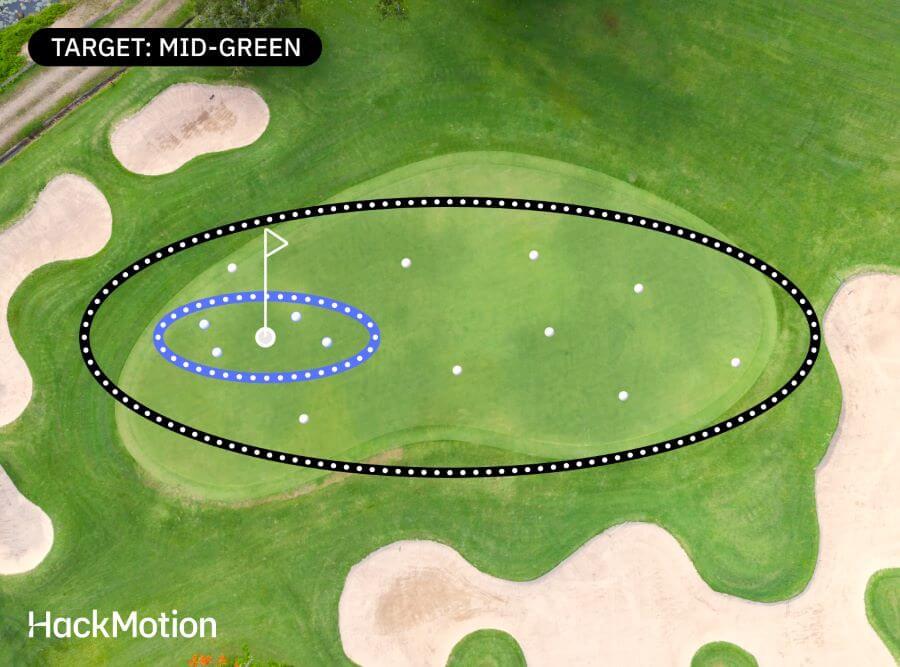
Time Your Pre-Shot Routine and Stick to It
You probably already know that a pre-shot routine in golf is incredibly important. However, there is another important feature of a golf routine that people often forget; the timing of it.
Let’s say your routine is to stand behind the ball, look down the fairway, take one practice swing, and then come around the side and hit the ball.
For some golfers, this routine may take 15 seconds, and for others, it could take 30. The key is to establish a pace for your routine and then keep that pace from one round to the next.
Think about it when compared to other sports.
For instance, running. If you are a runner who can run 9-minute miles, if you suddenly switch to an 8-minute pace, it will probably throw off your stride and make you feel much less efficient at first.
The same can be said for golf. Use the timer on your phone to just get a general idea as to what feels comfortable for you, and then use it for every shot. (Even when you practice!)
Film Your Swing and Remove Unnecessary Movements
There is a lot of movement in the golf swing.
Some twisting, some turning, some shifting but for some golfers, movement can be a negative.
Many players incorporate too much movement into their swing.
One of my favorite golf swing tips is to look at your swing and work on making it more efficient.
- Are there movements you don’t need?
- Does the club go past parallel at the top? Does it get you any extra speed?
- How about your footwork and your weight transfer?
- What if you stayed more stable?
- Would you be more powerful?
Take some videos of your swing and compare them to those of a professional. Look at the swings frame by frame and pay close attention to things like head and hip movement.
HackMotion can give you an idea as to how to move your hands and wrists throughout the swing to ensure you are not becoming inefficient with those movements.
Use Ground Pressure for More Power and Better Balance
The ground is your friend in the golf swing, it’s where real power comes from.
By pushing into the ground with your feet and legs, you create torque that transfers through your body and into the club. The most powerful swings come from players who keep their weight centered and balanced.
At impact, check your footwork. If your weight is too far on your toes or heels, it shows up in your strike and divot pattern.
Strong legs matter, but only when they use the ground properly. Train this, and your consistency will go way up.
Practice Alignment with Visual Feedback Every Time
If you are hitting shots that are not going straight, the first thing you should check is your alignment.
To master alignment, always practice with an alignment stick down. You can use it as a guide.
Our eyes can play tricks on us when it comes to alignment. With so many variables in the game of golf, learn to eliminate alignment as a variable and set up to the target.
Reset Emotionally After Every Shot—Good or Bad
As a golfer, you must manage your emotions even when you hit the best shot of your life. Have you ever heard stories about amateur golfers who made a hole-in-one and then had an 8 on the next hole?
This is a classic example of not being able to manage emotions.
When a birdie comes in, that’s great. When a bogey comes in, you move on and look for the next birdie. Golfers with poor emotional regulation have turned what should be a 1 over par hole into a 3-over par hole rather quickly.
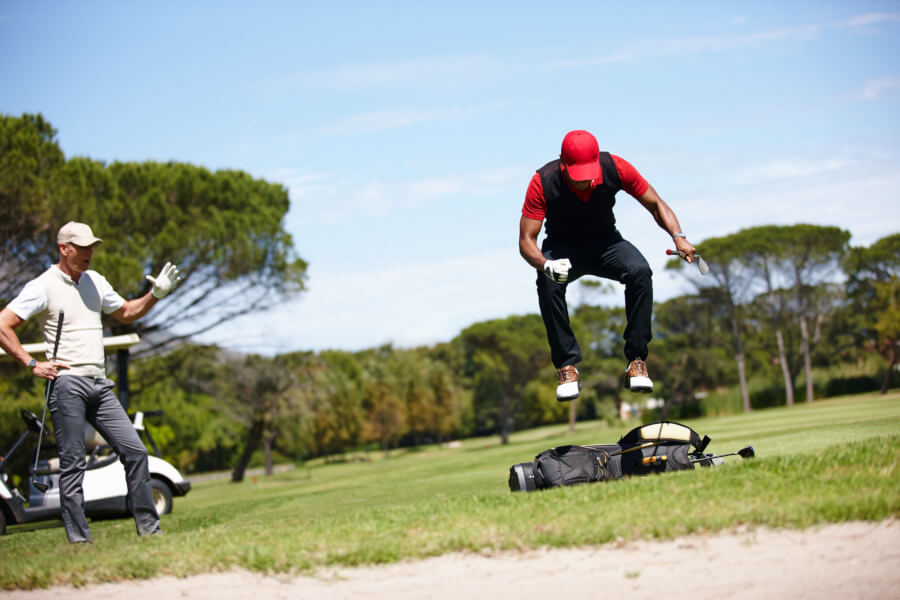
Keep Your Lead Arm Controlled—Not Locked Out
One of the most commonly shared advice from one amateur golfer to another is to keep the left arm straight.
It’s so important to have that left arm straight at impact and even at times during the backswing, but there are parts in the rest of the swing that having a left arm (too) straight will cause issues.
Golfers who are thinking of their left arm straight when they stand over the golf ball are going to be more likely to lift the club with their hands and not incorporate the lower body.
You can use the left-arm straight concept when you play golf, but make sure you know when and how it will impact ball flight.
We see many golfers’ swings with too much extension at the top simply because they are focused on keeping that left arm dead straight on the entire backswing.
Get Fit or Adjust Clubs That Fight Your Natural Motion
The equipment you use will impact your golf swing. You don’t necessarily need new equipment, but you do need equipment that fits your golf game.
Going for a custom golf club fitting will help you determine which equipment fits your game. Sometimes, as simple as a lie, angle adjustments can help you get a better setup and more consistency at impact.
FAQ
Here are a few common questions about the best golf swing tips.
What are 3 tips to improve your golf swing?
To improve your golf swing, create a repeatable pre-shot routine, develop a takeaway incorporating both the upper and lower body, and learn what the proper wrist position looks like at impact.
What is the best way to correct a golf swing?
The best way to correct a golf swing is to combine practice and technology. Technology like HackMotion can pinpoint issues, and then you put the time in to make sure they get corrected.
How can I truly improve my golf?
To improve your golf, you will need to study and invest time. Golfers who can improve and self-correct their golf swings know what they are looking for. You must also use technology to check in on your progress and ensure you are succeeding in your improvement plan.
How many years does it take to get good at golf?
Golfers take about 3 to 5 years to feel like they are at a point where they are comfortable with the sport and playing well. For some golfers, this can happen in a year; for others, it takes a lifetime. There is a certain amount of natural ability factored in here, along with time and dedication.
How can I improve my golf swing for beginners?
Beginners should study the golf game and continue practicing and working on their game. The more you can repeat the same motion, the easier it is to get better. Beginners struggle because they have too much inconsistency in their game.
Final Thoughts
You should now feel that you have a few things you can work on in your golf swing.
The most important part of implementing any of these swing tips is to start putting in the time.
With tools like HackMotion and a bit of time at the range, your golf swing can improve faster than you likely ever imagined.






